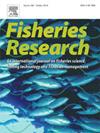寄生虫作为海洋渔业种群内变异的指标
IF 2.3
2区 农林科学
Q2 FISHERIES
引用次数: 0
摘要
新技术(档案标签、遗传标记、耳石微化学)正在揭示许多海洋鱼类种群结构的复杂性。在这里,Merluccius hubbsi 的寄生虫被评估为这方面的指标。该鱼种栖息于南纬 41 度至 55 度之间的阿根廷海域,该区域海洋条件的纬度梯度可能会影响寄生虫群的结构。对来自南部种群(236 尾)的 8 个样本和来自北部种群的 1 个样本进行了寄生虫分析,发现了 5-17 个分类群。选取了寿命较长的物种(主要是幼虫或包囊寄生虫)作为标记,并根据布雷-柯蒂斯异质性采用多元方法进行了分析。不同生物群之间的显著差异揭示了其相似性的明显纬度模式。这表明,在南方种群分布的极端地区捕获的无须鳕所寄生的寄生虫种群受到环境条件的不同影响。因此,在使用寄生虫标签作为种群鉴定工具时,应仔细考虑种群内寄生虫群的差异。这是因为要为实现管理目标提供足够的信息,就必须准确反映种群结构,特别是在研究栖息在大面积或海洋异质区域的鱼类种群时。本文章由计算机程序翻译,如有差异,请以英文原文为准。
Parasites as indicators of intra-stock variability in marine fisheries
The complex nature of population structure in many marine fishes is being revealed by new techniques (archival tags, genetic markers, otolith microchemistry). Here, parasites of Merluccius hubbsi were evaluated as indicators in that sense. This species inhabits the Argentine Sea between the 41°S and 55°S, a region characterized by a latitudinal gradient of oceanographic conditions that could influence the structure of parasite assemblages. Eight samples from the southern stock (236 hakes), and one from a northern stock were analyzed for parasites, finding 5–17 taxa. Long-lived species, mostly larval or encysted parasites, were selected as tags and analyzed by multivariate methods based on Bray-Curtis dissimilarities. Significant differences between assemblages revealed clear latitudinal patterns in their similarity. This suggests a differential effect of the environmental conditions over parasite populations harbored by hakes caught at the extremes of the distribution of the southern stock. Therefore, intra-stock differences in the parasitefauna should be considered carefully when parasite tags are used as tools for stock identification. This is because an accurate representation of population structure is necessary for providing sufficient information to achieve management objectives, particularly when studying fish populations that inhabit large or oceanographically heterogeneous regions.
求助全文
通过发布文献求助,成功后即可免费获取论文全文。
去求助
来源期刊

Fisheries Research
农林科学-渔业
CiteScore
4.50
自引率
16.70%
发文量
294
审稿时长
15 weeks
期刊介绍:
This journal provides an international forum for the publication of papers in the areas of fisheries science, fishing technology, fisheries management and relevant socio-economics. The scope covers fisheries in salt, brackish and freshwater systems, and all aspects of associated ecology, environmental aspects of fisheries, and economics. Both theoretical and practical papers are acceptable, including laboratory and field experimental studies relevant to fisheries. Papers on the conservation of exploitable living resources are welcome. Review and Viewpoint articles are also published. As the specified areas inevitably impinge on and interrelate with each other, the approach of the journal is multidisciplinary, and authors are encouraged to emphasise the relevance of their own work to that of other disciplines. The journal is intended for fisheries scientists, biological oceanographers, gear technologists, economists, managers, administrators, policy makers and legislators.
 求助内容:
求助内容: 应助结果提醒方式:
应助结果提醒方式:


